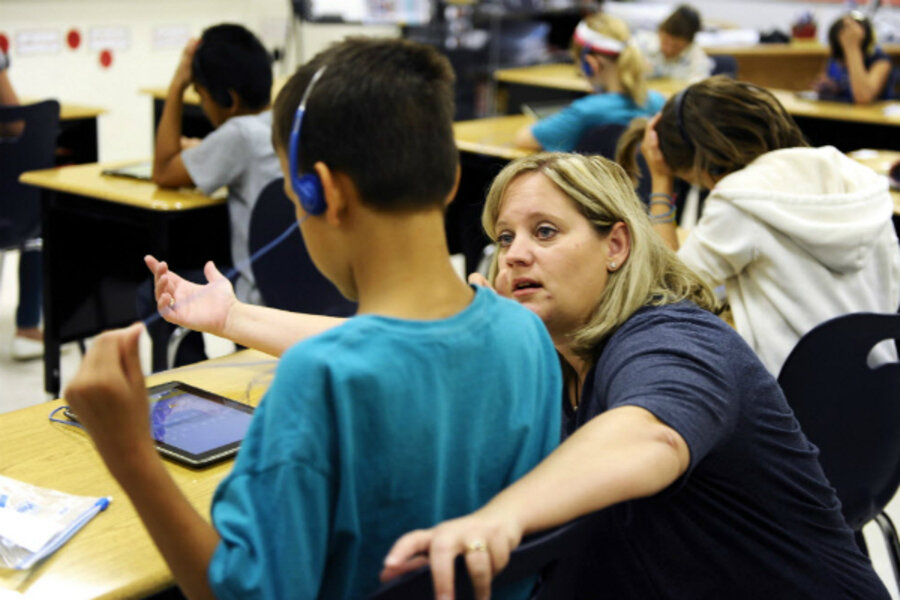Teacher status around the world: how the US stacks up
Loading...
Debate about how to keep up with countries that perform best on international tests has been percolating for years in the United States. Now there’s a new comparison to consider – one that ranks 21 countries on the status of teachers, a factor that experts say can influence the effectiveness of education.
China tops the first-ever Global Teacher Status Index, with Israel coming in last. The US ranks ninth – beating out No. 13 Finland, a country that often ranks high in comparisons of student performance.
The index is based on surveys comparing teaching to other professions and how much respect the public says teachers get from students. The report also includes the context of teacher pay, the degree to which parents encourage children to become teachers, and public opinion on pay-for-performance policies. The Varkey Gems Foundation, a London-based nonprofit devoted to improving education for disadvantaged students, released the index Wednesday evening.
In the US, “there is consensus that we need to not just improve the status but also the performance of the profession,” and the two go hand-in-hand, says Tom Carroll, president of the National Commission on Teaching & America’s Future, in Washington. An international comparison on teacher status is a valuable addition to the increasingly global dialogue about how best to do that, he says.
In China, about one-third of those surveyed said teachers could be compared with doctors. In two-thirds of the countries (including top-performers in student testing such as Singapore, South Korea, and Finland), the profession was most often compared with social work. In the US (along with Brazil, France, and Turkey), the most common comparison was to librarians.
That’s telling, says Mr. Carroll, because it means that the US public sees “the core role of teachers as providing students access to content,” which for so long has been measured by multiple-choice tests, while “the countries that say it’s like social work [are saying] teachers need to collaborate with students, support their personal and emotional growth, and work in teams.”
That latter approach is key to the success of many top-performing countries, Carroll and other education experts say, and it’s a shift that has more potential than ever to occur in the US as schools start to implement Common Core State Standards, which demand that students not just learn facts and figuring, but also how to apply knowledge and solve problems.
To the degree that state policymakers realize that potential of the Common Core, Carroll says, it will put “students in a tremendous position in a globally competitive economy.”
Top-performing countries all do several things the US could emulate better, says Betsy Brown Ruzzi, who focuses on international benchmarking as vice president of the National Center on Education and the Economy in Washington. “They recruit teachers at a minimum from the top third of the achievement cohort…. They also pay them well…. And when they enter teaching, they are treated like professionals,” she says.
Yet high status and high salaries don’t always correlate, this new report shows.
Adjusting salaries relative to the cost of living so that countries can be compared, the report shows that Egypt, ranking sixth on the status index, has an average teacher salary of just $10,604 a year. In Israel, which ranks last, teachers make $32,447.
“In many countries, a teacher is a civil servant,” where the salary might be low but where other factors, such as respect and stability, come into play, says the index report’s co-author Oscar Marcenaro-Gutierrez, a professor of applied economics at the University of Malaga in Spain.
In another look at the public’s views of salaries, the report shows that those surveyed in the US guessed that secondary school teachers earned a starting wage of about $36,000 a year; they said a fair wage would be about $41,000, while the actual wage was about $45,000.
Better pay would help improve status, but it would need to be accompanied by more selectivity in education schools and training programs, because “the public is unlikely to want to [raise pay] if the profession is seen as open to anyone regardless of aptitude,” says Kate Walsh, president of the National Council on Teacher Quality in Washington.
In ranking three categories of teachers among 11 other professions (listing them from 1 to 14 in terms of status), teachers averaged a ranking of seven across all countries. China, South Korea, Egypt, and Greece ranked teachers the highest.
China was the only country where at least half of parents said they would likely encourage their children to become teachers.
The US did well in the measure of parents’ trust in teachers, coming in fourth, just behind China.
One lively debate in the US that is touched upon in the index report is whether to link teacher pay to students’ performance. Across the 21 countries, an average of 75 percent supported the idea. In the US, 80 percent did.
But it’s difficult to know how reliable that finding is for the US. In the 2013 PDK/Gallup Poll of the Public’s Attitudes Toward the Public Schools, 58 percent oppose requiring teacher evaluations to include student scores on standardized tests.
Finland is known to have a high respect for teachers, generally, for instance, so the rankings are surprising and the methodology needs to be scrutinized, says Arthur Levine, president of the Woodrow Wilson National Fellowship Foundation in Princeton, N.J., and an advocate for improving teacher preparation in the US.
Overall, he’s disappointed to see some low figures on respect and trust of teachers. “This is, with the possible exception of China, a stinging critique of the teaching profession and the status in which we hold it," he says.
The good news, says Ms. Ruzzi, is that “it is possible to change public policy to improve the respect of teaching.”






